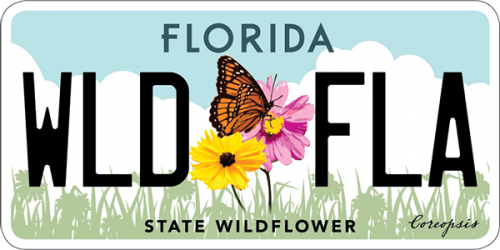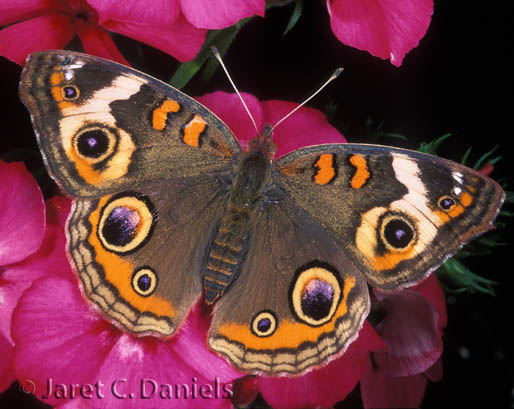- Family name: Nymphalidae/Brush-Footed butterflies
- General description: Forewing brown with two orange cell bars and a white subapical band enclosing a single large eyespot; hindwing brown with to large eyespots and an orange submarginal band. Ventral hindwing seasonally variable; summer form (wet season) individuals light brown with a darker postmedian band including several small dark spots; winter form (dry season) individuals reddish-brown with less conspicuous pattern elements.
- Field Marks: forewing brown with two orange cell bars and a white band enclosing a single large eyespot; hindwing brown with two large eyespots and a orange submarginal band. Ventral hindwing mottled brown to red.
- Sexes: Appear similar
- Wingspan: 32-60 mm
- Life Cycle: Egg: green, laid singly on host leaves Mature larva: black with white stripes marked with orange and numerous black branched spines Chrysalis: light brown with darker markings
- Number of Generations: 3 or more per year
- Flight Season: All year
- Abundance: Common
- Habitat: Forest margins, beaches, pastures, wet meadows, old fields, disturbed sites, roadsides, gardens
- Larval Host Plants: Plantain (Plantago spp.), False Foxglove (Agalinis fasciculata), Florida Toadflax (Linaria floridana), Blueheart (Buchnera americana), Twinflower (Dyschoriste oblongifolia), Frogfruit (Phyla nodiflora)
- Similar Species: No similar species
- Additional Information: Migratory; adults overwinter in reproductive diapause. Range is limited in Colorado, Nevada and Oregon.
- Range in Florida
 The Florida Wildflowers & Butterflies projects at the Florida Museum are sponsored in part by the State of Florida and the Florida Wildflower Foundation, Inc.
The Florida Wildflowers & Butterflies projects at the Florida Museum are sponsored in part by the State of Florida and the Florida Wildflower Foundation, Inc.
